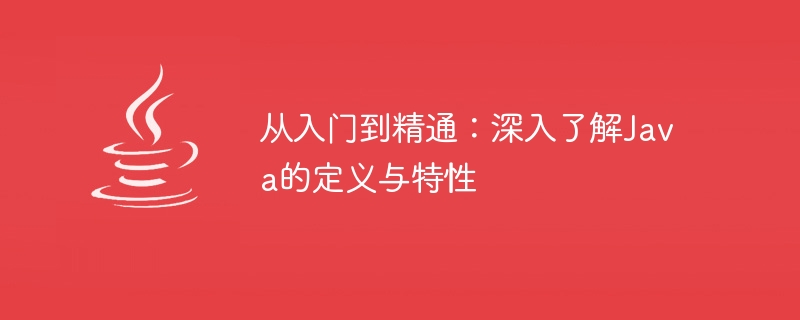

Java is a high-level programming language that is widely used to develop various applications. It was first released in 1995 by Sun Microsystems and subsequently maintained and developed by Oracle Corporation. Java's design goals are portability, object-orientedness, security, and efficiency. Its development process has gone through more than twenty years, and now it has become one of the most popular programming languages in the world.
Java’s definitions and features are very rich and diverse, from simple syntax rules to powerful class libraries and frameworks, each of which is worthy of in-depth exploration. In this article, we will take an in-depth look at the definition and features of Java from beginner to proficient.
First, let us understand the definition of Java. Java can be regarded as an object-oriented, general-purpose, cross-platform programming language. Object-oriented means that Java can be programmed by defining classes, creating objects and calling methods. Versatility means that Java can be applied to a variety of different fields, including web applications, mobile applications, embedded systems, etc. Cross-platformness is one of the important features of Java. It can run on different operating systems and hardware platforms.
Secondly, let us understand the characteristics of Java. The first is simplicity. Java adopts concise and clear syntax rules, allowing programmers to get started quickly and write code easily. Second is portability. Java's compiler compiles Java code into bytecode, an intermediate code that can run on any operating system that supports the Java Virtual Machine (JVM). This feature makes Java programs highly compatible and portable.
Java also has a garbage collection mechanism. Garbage collection refers to the automatic release of memory that is no longer used, so that programmers do not need to manually manage memory allocation and destruction. This greatly simplifies the complexity of memory management and reduces the risk of memory leaks. In addition, Java also has an exception handling mechanism. Exceptions are error conditions that may occur during program running. Java provides a set of standard exception classes and handling methods to make the program more robust and stable.
Java is also robust and secure. Java's compiler checks for syntax errors at compile time and catches exceptions at runtime, which prevents the program from crashing or producing unexpected results. In addition, Java also provides security mechanisms, such as permission management, security sandbox, etc., to protect programs from potential malicious attacks.
Java also has rich class libraries and frameworks. Java's standard library provides a large number of classes and methods that can be used to handle various common tasks, such as string processing, network communication, graphical interfaces, etc. In addition, the Java ecosystem also has many popular open source frameworks and libraries, such as Spring, Hibernate, etc., which provide rich functions and tools that can simplify the development process and improve the maintainability and scalability of the code.
Finally, let’s discuss how to go from getting started to becoming proficient in Java. First, we need to learn the basic syntax and syntax rules of Java. You can learn by reading books, attending training classes or online tutorials. Secondly, we need to practice writing some simple programs to consolidate the knowledge we have learned and learn to debug and solve problems. Then, we can delve into advanced features of Java, such as multi-threading, IO operations, network programming, etc., to expand our skills.
In addition, it is also very important to understand some common frameworks and libraries in the Java ecosystem. You can choose some popular frameworks and learn to use them to develop actual projects. In practice, we will encounter a variety of problems and challenges, which will prompt us to continue learning and progress.
In short, Java is a powerful and widely used programming language. Understanding the definition and characteristics of Java is very helpful to improve your programming abilities. Through in-depth study and practice, we can go from beginner to proficient in Java and apply the knowledge we have learned in actual projects. Whether you are a beginner or an experienced programmer, you should continue to learn and improve to maintain a deep understanding and mastery of Java.
The above is the detailed content of Comprehensive analysis of Java definitions and features: from entry to proficiency. For more information, please follow other related articles on the PHP Chinese website!